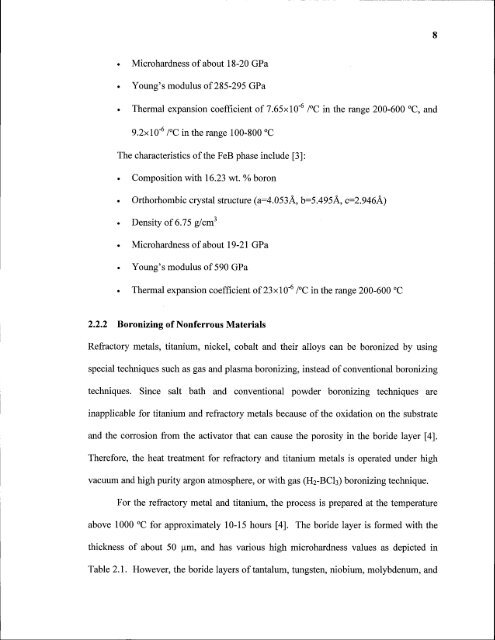Multi-component boron coatings on low carbon steel AISI 1018
Multi-component boron coatings on low carbon steel AISI 1018
Multi-component boron coatings on low carbon steel AISI 1018
You also want an ePaper? Increase the reach of your titles
YUMPU automatically turns print PDFs into web optimized ePapers that Google loves.
8<br />
• Microhardness of about 18-20 GPa<br />
• Young's modulus of 285-295 GPa<br />
• Thermal expansi<strong>on</strong> coefficient of 7.65x10 -6 7°C in the range 200-600 °C, and<br />
9.2x10 -6 /°C in the range 100-800 °C<br />
The characteristics of the FeB phase include [3]:<br />
• Compositi<strong>on</strong> with 16.23 wt. % <str<strong>on</strong>g>bor<strong>on</strong></str<strong>on</strong>g><br />
• Orthorhombic crystal structure (a=4.053A, b=5.495Å, c=2.946Å)<br />
• Density of 6.75 g/cm3<br />
• Microhardness of about 19-21 GPa<br />
• Young's modulus of 590 GPa<br />
• Thermal expansi<strong>on</strong> coefficient of 23x10 -6 /°C in the range 200-600 °C<br />
2.2.2 Bor<strong>on</strong>izing of N<strong>on</strong>ferrous Materials<br />
Refractory metals, titanium, nickel, cobalt and their alloys can be <str<strong>on</strong>g>bor<strong>on</strong></str<strong>on</strong>g>ized by using<br />
special techniques such as gas and plasma <str<strong>on</strong>g>bor<strong>on</strong></str<strong>on</strong>g>izing, instead of c<strong>on</strong>venti<strong>on</strong>al <str<strong>on</strong>g>bor<strong>on</strong></str<strong>on</strong>g>izing<br />
techniques. Since salt bath and c<strong>on</strong>venti<strong>on</strong>al powder <str<strong>on</strong>g>bor<strong>on</strong></str<strong>on</strong>g>izing techniques are<br />
inapplicable for titanium and refractory metals because of the oxidati<strong>on</strong> <strong>on</strong> the substrate<br />
and the corrosi<strong>on</strong> from the activator that can cause the porosity in the boride layer [4].<br />
Therefore, the heat treatment for refractory and titanium metals is operated under high<br />
vacuum and high purity arg<strong>on</strong> atmosphere, or with gas (H2-BCI3) <str<strong>on</strong>g>bor<strong>on</strong></str<strong>on</strong>g>izing technique.<br />
For the refractory metal and titanium, the process is prepared at the temperature<br />
above 1000 °C for approximately 10-15 hours [4]. The boride layer is formed with the<br />
thickness of about 50 µm, and has various high microhardness values as depicted in<br />
Table 2.1. However, the boride layers of tantalum, tungsten, niobium, molybdenum, and
















